
06/13/2012
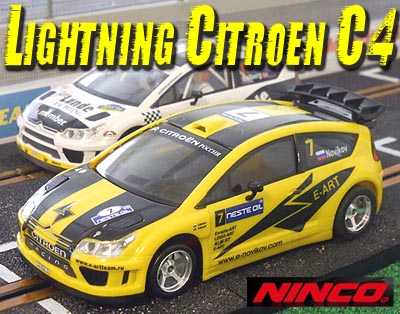
1/32 NINCO LIGHTNING Citroen C4 WRC NOVIKOV
I have a reasonably good selection of rally
cars, primarily from NINCO and SCX. They range from a low end of cars that are
available for anyone to run, including kids and beginners, to a high end that
includes the current generation of NINCO "Lightning" that features V.03 ProRace
components. If I had to pick a class of slot car that I personally have the most
fun with it would be rally. So, when I learned that NINCO was releasing a
version of the Citroen C4 that uses the next generation of Lightning technology,
my ears stood straight up.
Enter the NINCO Lightning Citroen C4 NOVIKOV. The 1:1 version itself didn't
exactly make WRC history. It was driven for the Citroen Junior Team during the
2009 WRC season by Evgeny Novikov, Dale Moscatt and others. It's best finish was
fifth in the Rally d'Italia Sardegna and a 13th place overall in the point
standings. The specific decoration chosen by NINCO ran in the Neste Oil Rally of
Finland where it ran well but did not finish (no pun...).
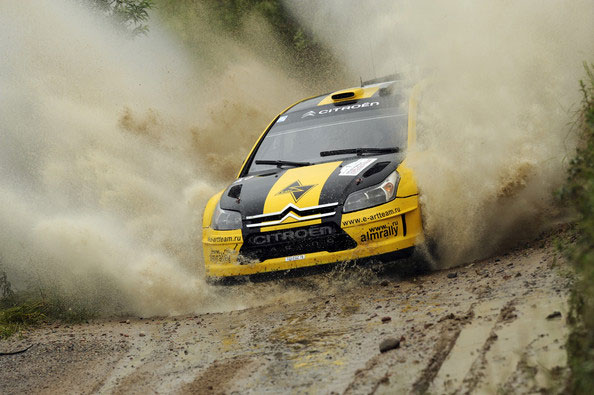
Regardless, I like the car's appearance and I am definitely intrigued by the
inclusion of the latest Lightning ProRace implementation in an AWD rally car. In
addition to the V.03 Aluminum/Magnesium 5 spoke set screw wheels and ProRace EVO
AWD pulleys, this C4 features a new angle winder motor pod with an adjustable
spring loaded rear suspension and a new straight tooth 29 tooth crown gear —
claimed to be more effective with a wider selection of pinions.
To my casual eye the paint and Tampo printing are very well done. The yellow
appears to be the color of the plastic, however, the very good clear coat
application makes this appear closer to a painted finish. The fit of the glass,
lights and other external parts did not reveal any serious gaps or flaws. The
interior is the light weight, low detail Lexan type, reasonably visible through
the relatively dark tinted glass. This leaves lots of room inside the body in
case any of the various digital systems' decoder chips may be installed.
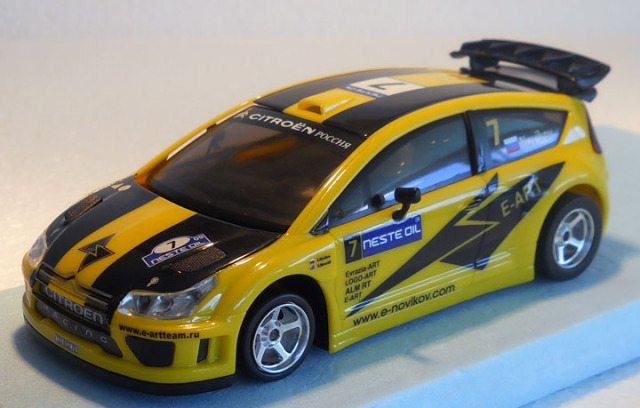
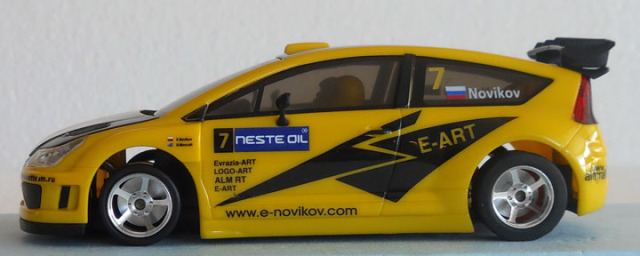
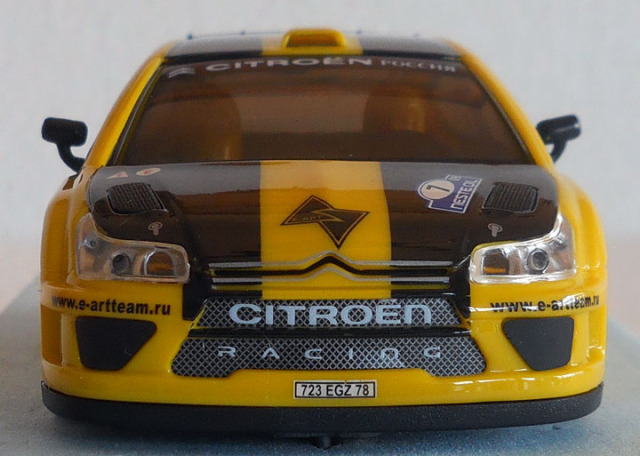
The detail and finish of the wheels are definitely above average. My photography
does not show it well, but they have a bright chrome finish. What looks like a
brake rotor is actually the AWD pulley. Wheels and tires appear to be round and
true with no evidence of wobble observed.
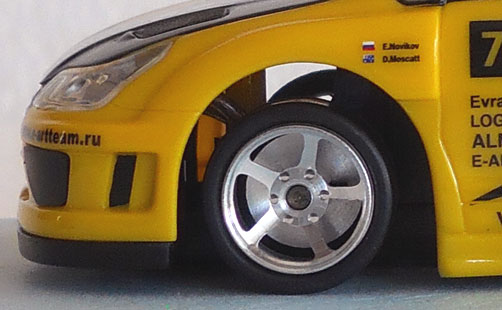
----------
Removing the body reveals an interesting chassis. Carried forward from recent
Ninco WRC Lightning offerings are the V.03 set screw wheels for 3/32" axles, the
ProShock medium shocks (only in front) and the ProRace EVO AWD pulleys for 3/32"
axles. The motor is the NC-14 Speeder +, which is the successor to the venerable
NC-5. It is very close in RPM and torque specification but touted to have
significantly higher magnetic down force. I'm not sure if this motor has
appeared in previous WRC cars. Note that the car comes without a magnet. The
collars on the front axle are a nice touch that eliminates horizontal play
allowing the front and rear pulleys to maintain alignment.
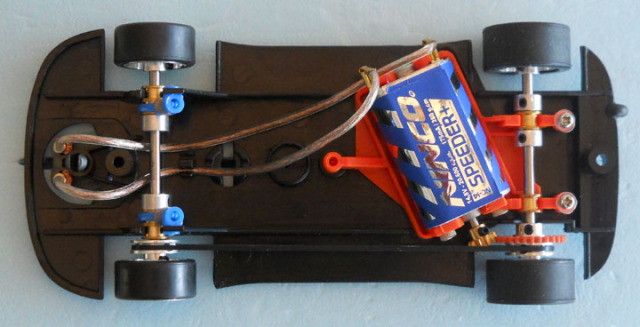
New in this model is the ProRace Motor Mount, but in this case it is the ProRace
Suspension Motor Mount with spring-loaded screws in the rear for
adjusting the rear suspension tension. This obviously replaces the rear shocks
in previous WRC models. Until now, NINCO WRC models equipped with the ProShock
suspension allowed the rear axle to move vertically in relation to the motor
mount which could sub-optimize gear mesh. This new system will allow ample
vertical travel while maintaining rear axle/motor alignment.
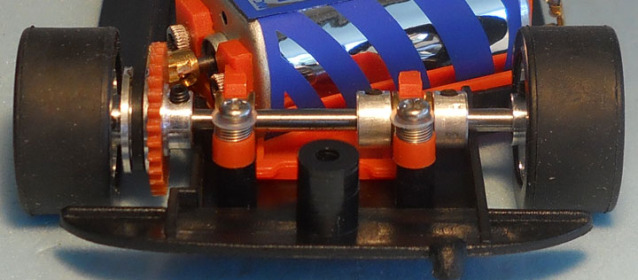
Also new is the V.03 29 tooth crown gear. Referred to separately in NINCO
literature as XGear. According to Ninco, the gear has a "straight tooth design"
which allows compatibility with a wide range of pinions. This car has a 11 tooth
ProRace V.03 pinion.
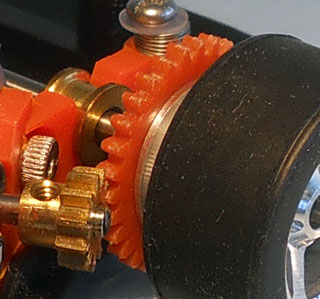
On a somewhat peculiar note, the body mount screws in this car look like some
sort of wood screw (shown on the left in the photo below). They seemed to hold
the body in place and allowed a small amount of float but were relatively short.
So, I replaced them with ProRace metric screws (on the right) which fit just
fine and allow more float adjustment between body and chassis.
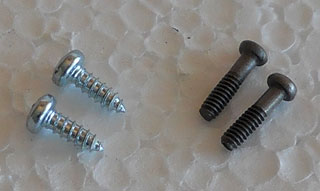
Normally at this point I would install an N-Digital chip, lubricate everything
and perform any tuning necessary for NINCO/N-Digital track. However, because
this is a Lightning car with some noteworthy new features, I decided to test and
break things in initially using the analog track. So, I removed the car from its
case, flared the standard braids out a little and, with no adjustment or
lubrication at all, went straight to the track. My analog setup is quite simple
utilizing the standard NINCO analog power base and 55 ohm controller. After just
a few laps it was apparent that something was not right. The car ran much slower
than expected and was quite "twitchy" at low throttle. It didn't take long to
find the problem(s): the relative position of the crown and pinion was too
close, creating a mesh that was far too tight. The mesh felt smooth when turning
the wheels by hand, but as though something was binding. Also one of the axle
collars (I can't remember which one) was binding. I went through every set screw
component checking position and tightness, adjusting where necessary. Moving the
crown inward by one or two taps solved the main problem. After this the car
started to show its real potential.
Following the above adjustments I lubricated all axle bushings, motor bushings,
the guide post and the gears. This also had an immediate positive effect because
there was no visible sign of lubrication of the car to be found anywhere. No
motor pod or body float adjustments were made yet. So, with my twisty, bumpy,
technical NINCO track configured for analog operation I ran the car first at 12
and then at 10 volts. I do not have lap timing when my track is configured
analog, however, after about 100 laps of progressively harder running I reached
three conclusions based solely on subjective observation: 1.) the drive train
break in process was progressing remarkable quickly; 2.) the increased magnetic
down force of the NC-14 was obvious, but not overwhelming; and 3.) this car was
definitely going to be a superior performer — certainly on my track.
At 12 volts the car was drivable but a little too stressful for my track, but at
10 volts it was exciting yet still a pleasure to run. Speed on the straights was
obvious and it powered through all the turns with confidence. There was no
fishtailing at all and the increased down force of the NC-14 made it somewhat
difficult to slide, but after getting a feel for the handling it was possible to
induce a very subtle, consistent controlled slide through standard curves.
---------
Next it was time to install the N-Digital decoder chip and the Ninco ProRace
Suspension guide with ProRace braids. I could have installed the guide prior to
analog testing but I decided to keep the car completely stock up to this point.
Below are all the components installed as part of the N-Digital conversion.
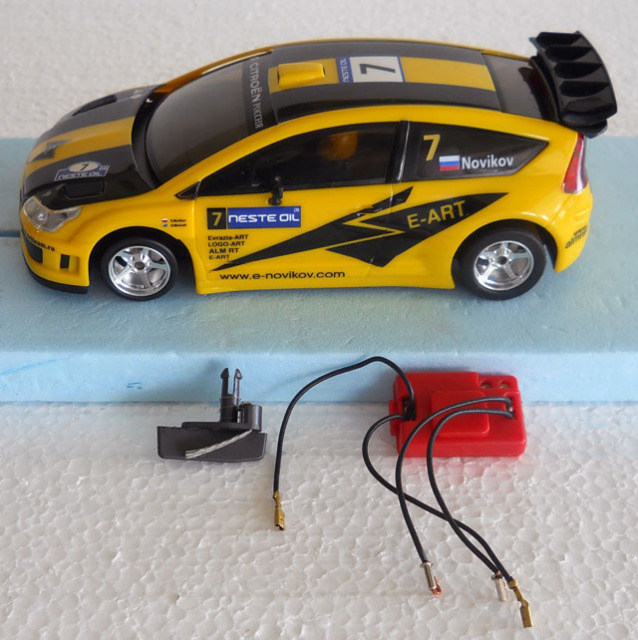
Pictured in the lower right below is the chassis with the N-Digital chip
installed. As expected, the conversion was very simple because of the ample room
afforded by the flat Lexan interior. Also pictured below is the chassis of the
Lightning Citroen C4 REMEMBER with the N-Digital chip installed. This represents
the prior Lightning WRC versions which feature the transparent Lexan chassis,
NC-5 motor (in this case) and a ProRace in-line drive train. There is really
nothing else to do to the new car for N-Digital operation so I decided to use
the N-Digital testing as a means to compare performance of the two Lightning WRC
setups. I feel that the relative results will be valid regardless of whether the
track is analog or digital.
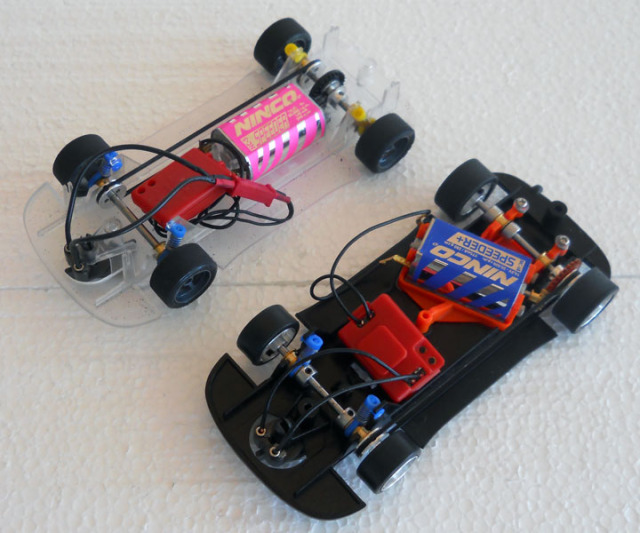
At this point I loosened the front motor pod screw one-half turn. I left the
motor pod rear suspension screws in their original state which seemed to be
about half way down. I decided to go with these settings based on the subjective
feel of the allowable motor pod movement. Even in this position I would describe
the pod as "loose". I left the metric body mount screws alone because they are
designed to provide two or three mm of float in their fully tightened position,
depending on body and chassis characteristics of course. Just a side note that
one drawback to this type of suspension system is that the body must be removed
in order to make adjustments.
The C4 REMEMBER is also without the magnet.
I ran both cars, individually, in three 25 lap sessions for each of the two
N-Digital throttle profiles. The results are shown in the following table:

The lap times speak for themselves. The advantage of the newer WRC setup is
quite significant. Note the greater disparity between the two cars in the
"professional' throttle profile. This would be analogous to running at a higher
voltage with a more aggressive throttle curve in analog. I believe that this is
an indication that the NC-14 provides a definite advantage when running without
magnets at higher voltage. The average and fast lap times of the C4 NOVIKOV
using the 'professional' throttle profile are among the fastest recorded no-mag
times on my track.
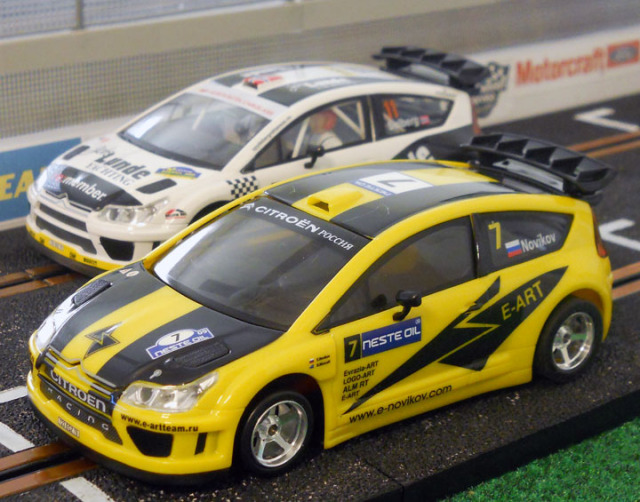
My philosophy regarding the rally class is that if the 1:1 car is AWD then the
slot car should also be AWD. I try to create the most realistic performance
possible, which is not necessarily all about raw speed. I believe that my
NINCO/N-Digital track provides an appropriate degree of realism because it is a
characteristically bumpy, uneven surface and my layout incorporates some
elevation changes, without being designed exclusively for rally. So, for
example, if I could reduce lap times by removing the AWD belt, I wouldn't do
that because it would run counter to the (my) higher goal. I do want the cars to
go fast, but within the broader parameters of realistic rally racing.
For me, the NINCO Citroen C4 NOVIKOV has the potential to elevate the entire
rally class. There is no rally car in my collection that can compete with it,
and it is bound to be formidable competition for virtually any 1/32nd rally car
currently available. As for the specific new features that are assumed to enable
this level of performance: the suspension motor pod; the straight tooth design
XGear? It would take more extensive, controlled testing than there is currently
time or space for here to determine empirically whether or not they really make
a significant difference. But one thing is undeniable — this car is a
significant step up from its comparably equipped predecessors.
In conclusion, if you're a rally slot car enthusiast you will
not be disappointed if you decide to acquire this car. I hope that others will
get the chance to run this car on different track surfaces and conditions
because I believe that it can be tuned effectively to run exceptionally well in
many slot racing environments. Let us know your experience.
Michael Ashton
Thanks Go To BRS HOBBIES For Sponsoring This NINCO Review
Copyright © 2012 HomeRacingWorld.com All Rights Reserved